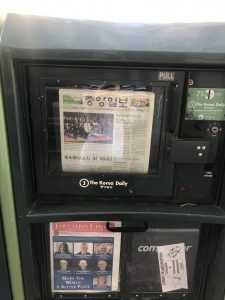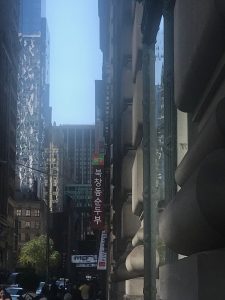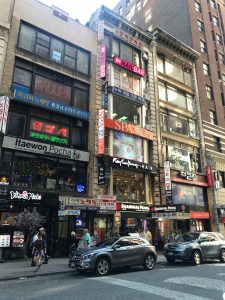Linguistic Landscape in New York City’s Koreatown:
For my project on linguistic landscapes, I choose to analyze Manhattan’s Koreatown. Koreatown is a small area comprised of just a few blocks, compared to the city’s more well-known and large ethnic enclaves such as Chinatown and Little Italy. Centered in Midtown, Koreatown is located right beside the Empire State Building and a few blocks away from Penn Station. According to the Asian American Federation Census Information Center, New York City is home to a large and growing Korean population. Currently, New York City is home to over 100,000 ethnically Korean residents, 67% of which reside in Queens and 19% of which reside in Manhattan. Although Manhattan’s Koreatown has a significant concentration of Korean residents within Manhattan and compared to Staten Island, Brooklyn and the Bronx, Koreatown is a misnomer when considering the actual demographics of New York City.
Although Koreatown is small, it is very dense with businesses. Many of the businesses that I observed while walking around in the area appeared to be small and Korean-owned. Although there were a few large multinational corporations such as CVS and Panera Bread, many of the large businesses with a presence in Koreatown such as Pinkberry and H Mart were either founded in Korea or founded by ethnically Korean people living in other countries. Compared to the example of DC’s Chinatown, highlighted by Leeman and Modan, which dealt with a wave of gentrification aiming to make the area appealing towards English-speaking tourists seeking a commodified brand of exoticism, Manhattan’s Koreatown seems to be more of an established center for Korean-owned businesses and services targeted towards Korean people. Although the area is very easy to navigate as an English-speaking person, Koreatown has a large amount of Korean signage and advertisements. Many of the signs that I observed while walking through the area featured Korean writing either exclusively or more prominently than its English counterpart. While walking through Koreatown, I passed a newspaper box with “The Korea Daily”. Although the sign labeling the newspaper was in English, the paper itself was written exclusively in Korean. Like the rest of New York City, Koreatown has a blend of cultural and linguistic representation. While walking the streets of Koreatown, you hear many different languages. Additionally, although Korean and English appear to be the most dominant languages represented in the area, there are many signs written in Japanese as well. Much of the advertising for food in the area markets itself as broadly Asian food or Asian fusion cuisine.
Similarly to most of Manhattan, Koreatown is dense with businesses that experience significant tourist traffic. However, unlike Leeman and Modan’s example of Washington DC’s Chinatown, Koreatown seems to have less of an emphasis on commodifying Korean language and culture to market it towards an outside audience. Although Koreatown is not the largest center of Korean residents in the New York City metro area, the prominence of Korean-owned businesses at both the small and large scale and the robust presence of Korean language in the linguistic landscape is evident of how Koreatown functions as a cultural center for Korean people in Manhattan.



Works Cited:
Asian American Federation Census Information Center. “Profile of New York City’s Korean
Americans: 2013 Edition.” Asian American Federation Census Information Center, 2013,
www.aafny.org/cic/briefs/korean2013.pdf.
Leeman, J & Modan, G. (2009), Commodified language in Chinatown: a contextualized
approach to a linguistic landscape. Journal of Sociolinguistics, 13(3), 332-362.
Hey Elizabeth! I really enjoyed this article. I thought the way you broke down the demographics of the area was very useful to understanding the cultural and linguistic make-up of the area. I was especially intrigued by the comparison you made to Koreatown in NY and Chinatown in DC. I was pleased to hear that you thought Koreatown seemed to be less exploitative, as I think it is a shame that language should be used for purely commercial means (especially if it is to the benefit of incredibly wealthy english companies which, frankly, do not need the extra revenue). Your observation of the Korean newspaper was also very unique, and I was surprised to hear that these were being sold! Overall, I really enjoyed your article and cannot wait to explore Koreatown myself!
Hey Elizabeth! Your article about New York’s Koreantown is very interesting. I really like the part where you compare Manhattan’s Koreantown with DC’s Chinatown. After reading your article, I understand that Manhattan’s Koreantown is less commercialized than DC’s Chinatown, as the signages in Koreantown are mostly designed for Korean clients. Also, the pictures are nice!
This was a really interesting linguistic landscape to read; as a Korean-American, I have always really enjoyed going to this area of NYC because it reminds me of my hometown. I agree that in Manhattan’s Koreatown, Korean culture seems less exoticized, and more of a space catered for Koreans – which makes me feel even more at home! I feel like it is a very productive space for the identity of Korean-Americans, where the two cultures can coexist. Overall, very well done! Hope your internship in NYC is going well 🙂
Hi Elizabeth! I really enjoyed your essay; I thought it was well structured with great content. I was impressed by the parallels drawn with the article by Leeman and Modan. I think in today’s society we are seeing more and more the commercialization of cultural hubs, and it is important to observe where this process of commercialization is tailored or disrupted to grow in specific locations. I hope you are enjoying NYC!